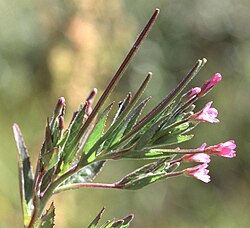| Epilobium ciliatum | |
|---|---|
 | |
| Epilobium ciliatum subsp. watsonii | |
| Scientific classification | |
| Kingdom: | Plantae |
| Clade: | Tracheophytes |
| Clade: | Angiosperms |
| Clade: | Eudicots |
| Clade: | Rosids |
| Order: | Myrtales |
| Family: | Onagraceae |
| Genus: | Epilobium |
| Species: | E. ciliatum |
| Binomial name | |
| Epilobium ciliatum | |
| Subspecies [2] | |
| |
| Synonyms [3] [4] [5] | |
List
| |
Epilobium ciliatum, known by the common names fringed willowherb, [6] American willowherb, [7] slender willow herb, and northern willow herb is a species of flowering plant in the willowherb family Onagraceae. This species is native to much of North America, southern South America, and East Asia. It is an introduced species in much of Eurasia and Australia. [8]
Contents
- Description
- Subspecies
- Taxonomy
- Distribution and habitat
- Invasiveness
- References
- Bibliography
- External links
This perennial herbaceous plant usually occurs in wetlands, but may be found in a great variety of habitats, including disturbed areas and roadsides, at elevations below 1,400 metres (4,600 ft). [8]
